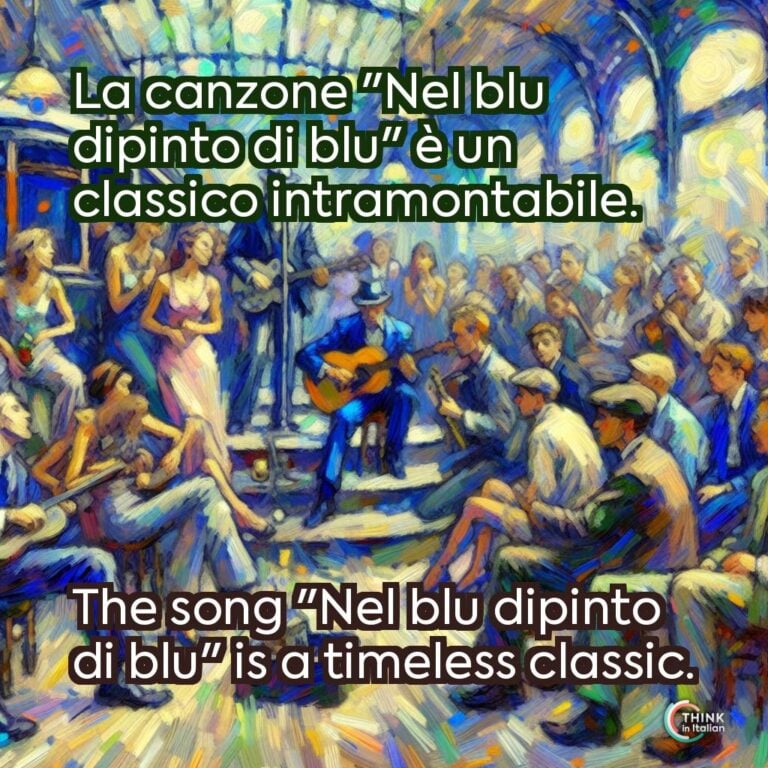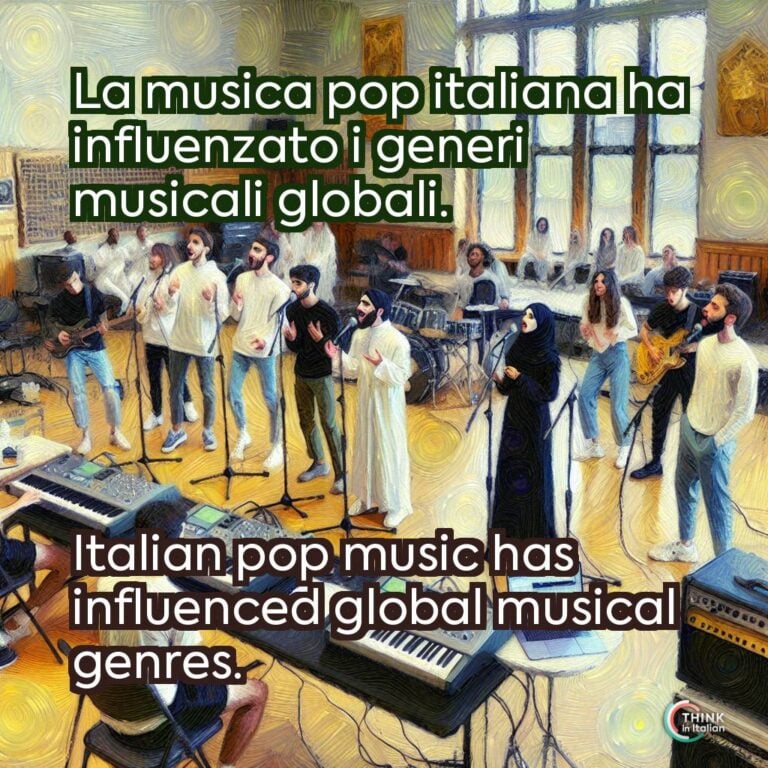The Evolution of Italian Pop Music
Post-War Beginnings: The Birth of Modern Italian Pop
The seeds of modern Italian pop music were sown in the 1950s, during Italy’s post-war recovery. Inspired by American jazz, swing, and rock ‘n’ roll, Italian artists crafted a unique sound rooted in melody and heartfelt lyrics.
One of the era’s most iconic songs was Domenico Modugno’s “Nel blu dipinto di blu” also known as “Volare”, the perfect Italian song to learn Italian!
It became a global sensation after winning the Sanremo Music Festival in 1958, thanks to its soaring melody and uplifting lyrics that symbolized Italy’s optimism and newfound confidence.
Volare, oh oh! Cantare, oh oh oh oh! remains a universal symbol of Italian creativity and joy. For language learners, singing along with classics like this proves that music helps learn a language, blending fun with education.
The 1960s: the Rise of Italian Pop
The 1960s brought a cultural revolution to Italy, and music was at its forefront. The Sanremo Music Festival became the launchpad for many artists, like Mina and Adriano Celentano.
Mina, with her powerful voice and bold personality, created timeless hits like “Se telefonando”, a perfect example of Italian pop’s emotional depth. Celentano blended rock influences with humor, creating unforgettable tracks like “24.000 Baci”.
This era also saw the influence of the British Invasion, with Italian bands like I Nomadi and Equipe 84 introducing rock elements into their music, creating a unique fusion that resonated with younger audiences.
The 1970s: Singer-Songwriters and Social Commentary
As Italy grappled with political unrest in the 1970s, music became a platform for reflection and resistance. The figure of cantautori (songwriters) emerged: singers who used their songs to explore themes of love, identity, and societal change.
Both my parents’ favorite Italian artists came from this amazing period. Among others, Lucio Battisti and Fabrizio De André are considered the pioneers.
Battisti’s “La canzone del sole” is still the most played song at parties whenever someone has a guitar. It evoked nostalgia with poetic lyrics.
De André’s storytelling tackled themes of war and freedom, and is an example of poetry in music. I remember that my middle school music teacher wanted us to listen to his music, as a proof of its relevance.
Progressive rock bands like Premiata Forneria Marconi (PFM) also pushed boundaries, incorporating intricate compositions and expanding Italian pop’s artistic scope.
For anyone exploring Italian music terms, this era introduced rich vocabulary and expressions that remain influential.
The 1980s: a Golden era for Italian pop
The 1980s marked a turning point as Italian pop gained international acclaim. Italo disco and synth-pop dominated the airwaves, with artists like Giorgio Moroder pioneering electronic music.
Eros Ramazzotti became a global sensation, blending pop, rock, and electronic influences in hits like “Terra Promessa”. Singing in both Italian and Spanish, he introduced Italian pop to Latin American audiences, bridging cultures together.
Toto Cutugno’s “L’Italiano” became an anthem of national pride, with its iconic line: lasciatemi cantare, con la chitarra in mano (let me sing, with a guitar in hand).
The 1990s: Experimentation and Fusion
The 1990s brought new voices and innovative sounds to Italian pop. Artists like Laura Pausini and Jovanotti expanded the genre’s reach with introspective lyrics and diverse influences.
These artists made my childhood. Laura Pausini’s “La solitudine” captured hearts worldwide with its emotional storytelling, while Jovanotti blended rap, funk, and world music, reflecting Italy’s evolving cultural identity.
Eros Ramazzotti continued his global success, collaborating with international stars like Tina Turner on “Cose della vita”. These cross-cultural partnerships showcased Italian pop’s versatility and universal appeal.
The 2000s to Today: Innovation and Global Recognition
In the 21st century, Italian pop has embraced a blend of tradition and modernity. Artists like Tiziano Ferro and Elisa redefined the genre with contemporary production and deeply personal lyrics.
More recently, Måneskin has brought rock-infused Italian pop to a global stage, winning Eurovision in 2021 with “Zitti e buoni”. Their success reflects the genre’s ongoing evolution, capturing the attention of younger audiences worldwide.
Why Italian Pop Music Matters
Italian pop music has captivated listeners for decades, evolving alongside the nation’s social, cultural, and political landscapes.
From its post-war beginnings to its global recognition today, Italian pop is a testament to the country’s passion for melody and storytelling.
Its timeless appeal lies in its ability to evolve while staying true to its roots. From the post-war optimism to the global success of Måneskin, the evolution of Italian pop music mirrors the nation’s history and creativity.
So, why not dive into the world of Italian pop? Explore iconic tracks, learn new words, and try singing along to these Italian songs. It’s a melodic journey that will deepen your appreciation for Italy’s culture and might even help you pick up the language along the way!








